|
Pick a Card
by Bob Brooke
When people think of playing cards, they usually
imagine classic aces, spades, hearts, clovers and diamonds. And let’s
not forget the king, queen and jack court cards. Most of these same
people probably have an old card deck stuffed in a drawer somewhere in
their homes. In fact, playing cards are so ubiquitous that they’ve
played a major role in entertainment for hundreds of years. Besides
helping friends or family spend a relaxing evening playing friendly card
games, there are those used to play bridge and poker. And don’t forget
all the cards used in casinos for black jack and other games.
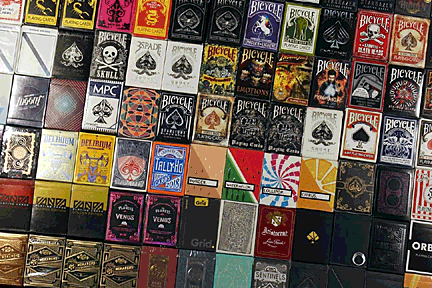
Historians believe the concept of playing cards originated in Asia,
eventually making its way to Europe via trading routes by the late 14th
century. In the Netherlands, cards became popular during the 15th
century as both a pastime and a means of socialization among nobility
and the growing merchant class. The oldest surviving deck of 52 playing
cards was made in The Netherlands around 1475.

The classic 52 deck of cards comes in
a wide variety of designs, so collecting playing cards can be very
rewarding. There are so many incredible, rare and beautiful decks—and so
many new ones released all the time—it’s almost impossible to know where
to begin. Beginning collectors will also find them in all price and
quality ranges, from inexpensive to rare decks, and those of mint
quality to inferior ones.
The Pros and Cons of Collecting Playing Cards
On the plus side, playing card collectors never run out of cards to
collect. All decks contain four common symbols—Clover, Club, Diamond,
and Heart. Those symbols and pictures of the cards themselves also
appear as decorations on a variety of objects that can greatly enhance a
collection.
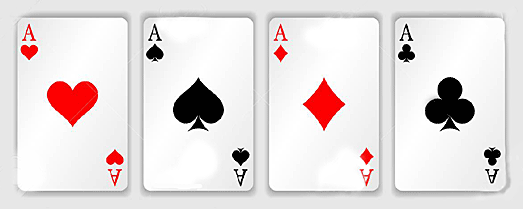
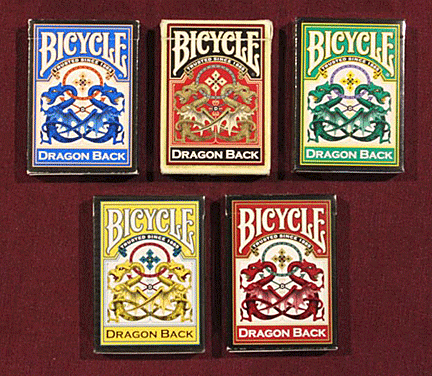 Most
collectors begin by collecting standard decks, that is any pack of cards
available at a local supermarket or convenience store. Buying one or two
standard decks is a great place to start, but they don’t make a
collection. Collectors who want to build a really good collection need
to focus on “custom” or “designer” decks. These are the same cards as in
a regular deck with the normal numbers and faces, but what makes them
different are their designs, decals and quality. By collecting many
different types of decks and designs, a collector can amass a fine
collection in no time. Most
collectors begin by collecting standard decks, that is any pack of cards
available at a local supermarket or convenience store. Buying one or two
standard decks is a great place to start, but they don’t make a
collection. Collectors who want to build a really good collection need
to focus on “custom” or “designer” decks. These are the same cards as in
a regular deck with the normal numbers and faces, but what makes them
different are their designs, decals and quality. By collecting many
different types of decks and designs, a collector can amass a fine
collection in no time.
On the minus side, collecting playing cards can be very expensive. On
average, standard decks cost about $10 each, but some of the fancier
ones can cost a whole lot more. Of course, there are some that are
cheaper, but these aren’t usually in such good condition. Those
collectors who wish to collect only new decks will have to spend quite a
lot to do so.
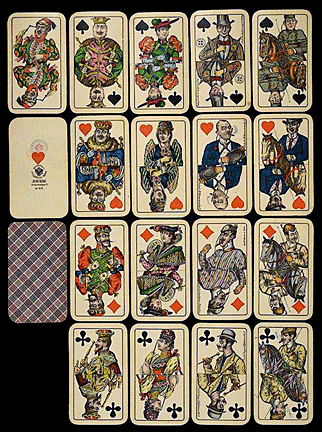 Collectors
never run out of cards to collect. The problem with collecting decks of
cards is that it’s almost impossible to stop. Even if a collector runs
out of space, he or she may discover a better deck to replace a
lesser-quality deck. Fortunately, it can take years to get to that
point. Collectors
never run out of cards to collect. The problem with collecting decks of
cards is that it’s almost impossible to stop. Even if a collector runs
out of space, he or she may discover a better deck to replace a
lesser-quality deck. Fortunately, it can take years to get to that
point.
A collection won't necessarily be worth a lot of money. Collectors often
find that only other collectors will pay more money for decks should
they choose to sell them. Unfortunately, collecting playing cards isn’t
something collectors do to make money.
Not every deck will contain a full set of cards. It’s important to check
every deck to avoid those that aren’t complete. Many used decks
naturally contain missing cards.
Some collectors like to play with some of the cards they collect. But
that could wear them out, which would diminish their value. The only
alternative is to buy duplicate sets, but that involves spending more
money.
How to Start a Playing Card Collection
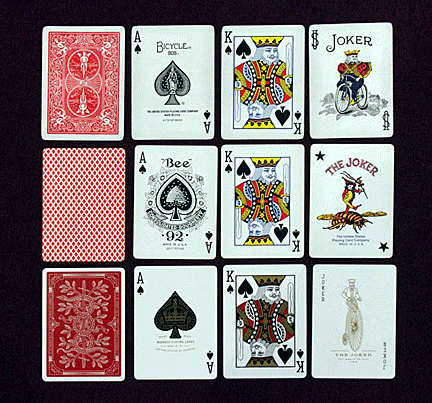 Novice
collectors may be wondering where to find those special custom-designed
decks. Standard ones can be found at garage sales and flea markets, but
to find the really special ones will take a bit of digging. Games and
magic shops often have in stock playing card decks that are unusual.
Beyond the obvious local places to find cards is the Internet. There are
plenty of trustworthy online stores that have all the unique and amazing
cards a collector could possibly wish for. Novice
collectors may be wondering where to find those special custom-designed
decks. Standard ones can be found at garage sales and flea markets, but
to find the really special ones will take a bit of digging. Games and
magic shops often have in stock playing card decks that are unusual.
Beyond the obvious local places to find cards is the Internet. There are
plenty of trustworthy online stores that have all the unique and amazing
cards a collector could possibly wish for.
The best part about collecting playing cards is that there are no rules
or playing cards that must be in a collection. Essentially, every
collection is a custom one. Collecting playing cards is a personal
affair because each deck added to a collection is the personal choice of
the collector. And because playing cards come in many shapes and sizes,
no two collections are ever the same.
Develop a Plan
It’s important for novice collectors to learn to spot the real values
and gems without losing their shirts. Failing to do so can lead to a lot
of disappointment and wasted money.
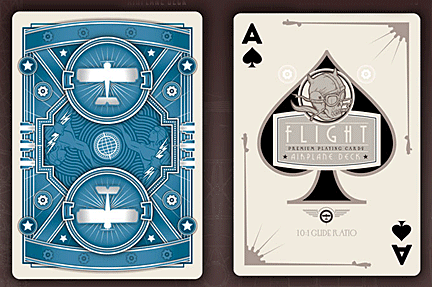 To
keep on track, smart collectors develop a plan. Tops on the list
deciding on how much money to spend on a collection. Setting clear
ground rules in advance is very important. To
keep on track, smart collectors develop a plan. Tops on the list
deciding on how much money to spend on a collection. Setting clear
ground rules in advance is very important.
Also, collectors must decide from the outset if they plan to use the
cards they collect. Whether or not the cards will be used plays a very
big role in determining what you the decks will be used for.
Many collectors like to open the cards and use them for anything from
magic to poker.
Collectors who are thinking about getting serious about collecting
playing cards need to think carefully before they begin breaking seals
and shuffling decks of cards with legitimate monetary value.
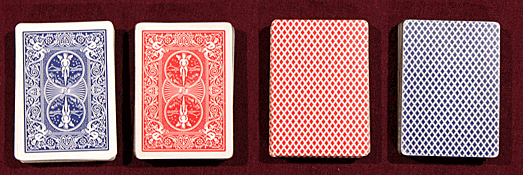
When it comes to pricing—rare and/or valuable cards are most valuable in
their unopened, sealed condition, much like toy collectibles. When a
collector breaks the seal and opens the box—the effect on the monetary
value of the deck can be brutal.
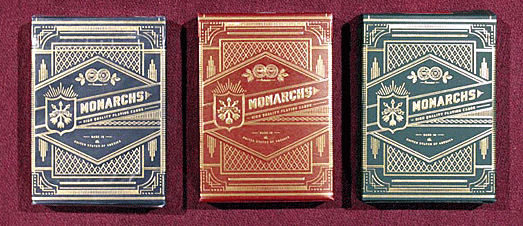
Those intending on collecting playing cards to sell later at a profit
cannot open the decks or play with them if they expect the cards to
retain their value as collectibles. Many purchase two of every deck they
buy, so that they have one to open and play with as much as they want
without worrying, and one to store in a safe place and keep in that
“perfect’ unopened condition. But this may not be possible with custom
or rare decks.
Displaying a Playing Card Collection
It can be a challenge to display a playing card collection. While the
boxes and backs of card decks may have interesting designs, displaying
some or all of the faces of cards in a collection can be daunting.
Besides all the different motifs, cards come in different shapes and
sizes. Some decks are long and wide, some short, some even round.
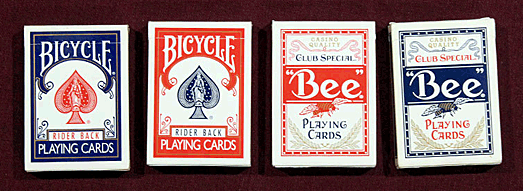
Card sleeves, available in office supply stores and online, are a great
way to display individual cards. This is the best way to protect cards
and show off the more interesting cards in a collection. Having stands
to prop them up on will make them stand out that much more. Multi-tiered
shelving can be a good way to display cards like this.
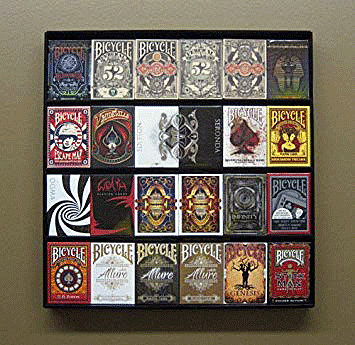 Some
collectors use flat display cases. Even though they can take up more
space, they’ll show off the front of the playing card decks. In most
cases, the front will show what the back of each card looks like, which
can be the neatest part. Unless you have a large area, using standard
size decks will be the easiest playing cards to put on display. Some
collectors use flat display cases. Even though they can take up more
space, they’ll show off the front of the playing card decks. In most
cases, the front will show what the back of each card looks like, which
can be the neatest part. Unless you have a large area, using standard
size decks will be the easiest playing cards to put on display.
Display uncut sheets of cards. This can be very expensive but can make a
collection stand out. Some collectors buy uncut sheets of playing cards,
have them framed, and display them near their collection.
Display one card from each deck in binders. Pull a joker out of each
deck and place them in binders that can be on display. Just use sheet
protectors that won't damage the cards and try to remember what deck
each card belongs to.
< Back
to Collectibles Archives
Next Article > |
